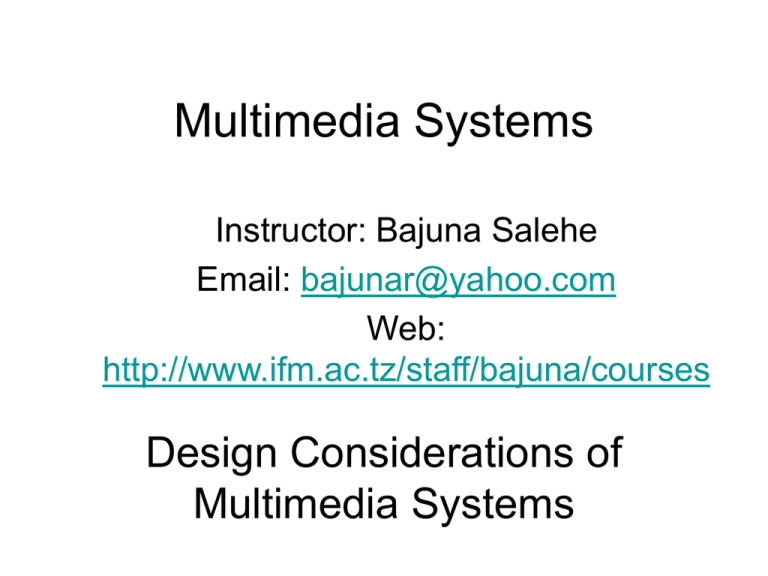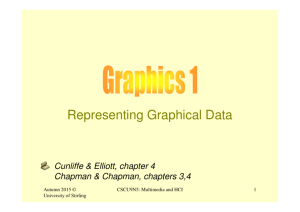Design Issues of Multimedia System
advertisement

Multimedia Systems Instructor: Bajuna Salehe Email: bajunar@yahoo.com Web: http://www.ifm.ac.tz/staff/bajuna/courses Design Considerations of Multimedia Systems Main Agenda • Human Computer Interaction (HCI) • Overview of Software Design Methods • General Methods of Multimedia System Design Human Computer Interaction (HCI) • HCI affects design decisions that are expected to be made during the development of Multimedia Systems. • The major focus of HCI is on ‘User Interface’ – The design of User Interface must well take into account what we call ‘user friendliness’ or ‘Usability’. Human Computer Interaction (HCI) • The following usability attributes should be considered in designing HCI: – Learnability – systems should be easy to use so that the user could be immediately be able to work with it. – Efficiency – System should be efficient to use to achieve high productivity once learnt well. Human Computer Interaction (HCI) – Memorability – The system should be easy to remember. – Errors – The system should have low error rate. – Satisfaction – The system should be pleasant to use to satisfy user. • Just get a quick review of HCI to have more recipes in Multimedia System Design. Overview of Software Design Methods • The design of multimedia systems follow the same underlying process of software engineering (SE). • Therefore the designer of multimedia systems should be aware of general methods of SE. – From Waterfall Model to Object Oriented System Design. User Interface Design Cycle • In designing user interface there are three stages: – Design stage – Collecting information about users’ needs (Requirement analysis). – Implementation/Prototyping Stage – A prototype system is implemented based on the information gathered. – Evaluation Stage – Evaluate the prototype, through users’ feedback before the final system is developed. Designing Multimedia Systems • Generally the design process of multimedia systems follows the following steps: – Identifying the requirements of the systems. – Identifying the design issues. – Implementation. – Testing and evaluation. Designing Multimedia Systems • These steps are not well enough to get the project start well in designing multimedia systems. • A multimedia systems requires detailed and well-planned approach toward media integration issues. – Handling mix of various medium such as audio, animation, text and graphics is the big challenge to the designer. System Requirement • This stage is comparable to the ‘requirement specification’. The stage has the following key functions: – Provide system definition which outlines the aims and the objectives of the system. – To clarify the potential users of the system. – To critically evaluate the required hardware as well as the available software platforms and authoring tools. Design Consideration • Draw up clear guidelines about the design details. • This stage aims at: – Design metaphor: Select a ‘real world mental model’ to be used as the key interface design solution for the system (i.e movie, a book, a game, … etc) Design Consideration – Information types and formats: Define information that needs to be integrated into the system, i.e. text, graphics, sound, video, and animation. – Navigational structures: To articulate a clear navigational strategy, including the link structure. – System controls: To clarify the types and features of controls and tools needed for the systems. • May include sound, video and animation controls. Important notes in Design of MS • Furthermore due to their complexity in nature multimedia systems design process should start by taking into consideration their unique characteristics. – The huge amount of data that needs to be processed and transmitted in a continuous manner, and the timing constraints that need to be satisfied in order to have an informational message meaningful to the enduser. Important notes in Design of MS • Another important characteristic is the Quality of Service (QoS) which embraces all the non-functional properties of a system (e.g. power consumption, cost, etc.). • In multimedia systems, QoS requirements vary considerably from one media type to another. – E.g the video streams require consistently high throughput (high bandwith), but can tolerate reasonable packet errors. Implementation • Once the design features are defined, the implementation phase of the system begins using multimedia-authoring tools. The implementation stage consists of: – Creating a prototype of the system. – Beta test the prototype for possible design and control problems. Evaluation • At this stage the system is evaluated against its stated goals. Different types of evaluation approaches including formative or summative could be used. – Formative evaluation is like doing system verification (see whether it works perfectly) – Summative evaluation involves letting users to use the system and getting feedback from them if it works according to the requirements.








